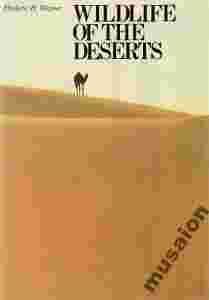|
Frederic H. Wagner
Wildlife of the Deserts
London 1980
Stron 231, format: 18 x27 cm
65 czarno-białych i 158 kolorowych ilustracji
Książka jest używana: naderwana obwoluta, poza tym bez defektów..
Wildlife of the Deserts
Frederic H. Wagner
223 illustrations, including 158 plates in full color
A blazing sun that sends air temperatures soaring to 50°C (145°F) in the shade . . . windblown sand that carves rocks into bizarre sculpture . . . powder-dry soil that has had no rain for ten years. This environment is one-of the harshest on Earth, forcing desert organisms to develop some of the most extreme and fascinating adaptations to cope with hardships they face. Burrowing lizards and rodents literally swim down into the sand to escape the heat, while Bataleur eagles of the Kalahari soar skyward on updrafts of air. During times of abundant food, Bactrian camels store fat in two large and distinctive humps, but in times of scarcity these growths shrink until the animal has merely a slightly arched back.
Those who think all deserts are merely vast seas of sand will be amazed at the variety shown in these pages: deserts shimmering with black stones, blooming with spring poppies and primroses, or dotted with palm-fringed oases. The illuminating text, accompanied by 158 magnificent color photographs, presents all types of deserts from the Sahara to the Kyzyl Kum of Central Asia, from the Atacama-Sechura of South America and Mojave of the United States to Australia's great deserts. The text is filled with informative and colorful accounts of pumas and jackrab-bits, roadrunners, sidewinder rattlesnakes, a North American leopard lizard that can run on its hind legs like a miniature dinosaur, scorpions, woolly tarantulas, and Gila monsters. The desert echoes with sound—the piping of a meadowlark, the scream of a red-tailed hawk, an autumnal chorus of coyotes. And cacti, bearing purple, golden, and crimson flowers, exist in almost endless forms: prickly pear, chollas, and towering saguaro and cardon.
Valuable additions to the text include descriptions and drawings of atmospheric circulation, topography, dune formation, oases, ephemeral lakes, and the accelerated life cycles of the creatures they support. There is also a supplement featuring desert lizards and succulents.
This is a book for anyone who admires the lonely grandeur of deserts and their inhabitants' miraculous capacity to survive.
Contents
Preface 10
Deserts: The Physical Environment 15
Desert Life-styles 35
Staying Gool in African and Arabian Deserts 63
The Search for Food: Deserts of Central and East Asia 89
Competition in Cold Deserts of the Americas 111
Predators and Prey: Hot Deserts of the Americas 137
Converging Evolution: Wildlife of Australian Deserts 169
Picture Credits 192
Appendixes 193
|

